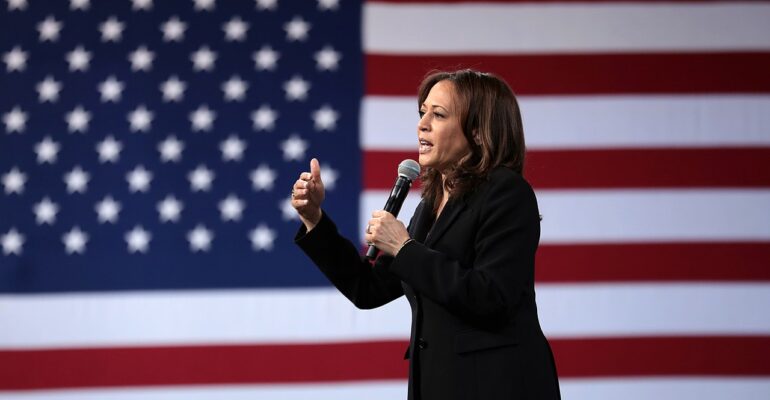Three storytelling lessons from Kamala Harris’ stirring victory speech

Three storytelling lessons from Kamala Harris’ stirring victory speech
In today’s edition, I’m sharing my quick take on some storytelling elements used in the victory speech by the US VP-Elect Kamala Harris.
(This being Diwali, I thought it’s appropriate to share a story about the victory of good over evil 😉
If you haven’t watched/ read the speech yet, you can do so here (video) and here (transcript).
It’s a powerful speech – emotionally resonant and yet clear headed. A fitting articulation of a historically significant moment.
In the address, Harris has used many storytelling techniques; I’m going to pick three interesting ones that caught my eye.
1. Begin with impact
You are stepping up to give a victory speech – one about gratitude for the millions who worked to get you here. How would you normally start?
Most would go: “Ladies and gentlemen, it gives me great privilege/honour to be here… ” or “I thank everyone from the bottom of my heart” etc.
But that’s predictable – wastes too much airtime on inanities that don’t really add value.
Here’s how Harris starts:
“Good evening.
Congressman John Lewis, before his passing, wrote: ‘Democracy is not a state. It is an act.‘”
It’s an evocative (and less-known) quote by John Lewis (a Civil Rights icon and leader of the Democratic Party, who recently passed away in July 2020). The quote is superbly chosen – it conveys an apt message in simple, evocative language and also pays homage to an iconic leader – who couldn’t be present at this historic moment of victory.
For your next speech/presentation, pay extra special attention to how you will begin. You could start with a thought-provoking question, a surprising factoid, a quote or an evocative story.
If you begin well, your audience will stay with you for the rest of the journey.
2. Use contrast
A good storyteller understands and uses the power of contrast – the juxtaposition of differing (often opposing) themes.
Here’s one example from the speech:
“I know times have been challenging, especially the last several months.
The grief, sorrow, and pain. The worries and the struggles.
But we’ve also witnessed your courage, your resilience, and the generosity of your spirit.“
The uplifting themes of ‘courage, resilience and generosity of spirit’ are further elevated by the contrast with the ‘grief, sorrow, pain, worries and struggles’ in the preceding sentences.
(Pro tip: If you spot the word ‘but’/’however’ in a speech, you’re likely to be in the presence of contrasting statements)
A few more examples:
“When she (Shyamala Gopalan Harris) came here from India at the age of 19, maybe she didn’t quite imagine this moment.
But she believed so deeply in an America where a moment like this is possible.”
”…what a testament it is to Joe’s character that he had the audacity to break one of the most substantial barriers that exists in our country and select a woman as his vice president.
But while I may be the first woman in this office, I won’t be the last“
”The road ahead will not be easy.
But America is ready. And so are Joe and I.”
It’s the juxtaposition that does the trick.
3. Anaphora and epiphora
Do you remember learning about ‘Figures of speech’ in school?
I do, and it was a favourite topic. In school though, we just scratched the surface of this vast and utterly fascinating topic.
You see, the Greeks (the original rockstars) had enlisted a wide range of literary devices that can be used to add impact to your writing. You would remember the usual suspects – alliteration, analogy, simile, metaphor etc.
(Incidentally, I highly recommend ‘The Elements of Eloquence‘ by Mark Forsyth for a delightful romp through a wide array of such rhetorical devices)
So what are these funny sounding devices – anaphora and epiphora?
Both employ the power of repetition – the repetition of a key word or phrase at the beginning (anaphora) or end (epiphora) of every sentence.
Consider this example. You could say:
“We will fight them in the beaches, landing grounds, fields, streets and hills.“
Clean, compact and simple. But utterly devoid of emotion. And rhythm.
Instead this is what Winston Churchill said:
“We shall fight on the beaches, we shall fight on the landing grounds, we shall fight in the fields and in the streets, we shall fight in the hills…“
That speech was rhythmic, that speech was rousing, that speech was one of the best ever… you get the idea.
Anaphora and epiphora are the dirty little secret of the speech-writer’s world. It’s incredibly easy, and incredibly effective. Do you want to rouse the audience? Do you want to leave a lasting impression? Do you want to sound like an important leader? Then you must use these devices. (See how easy it is though?!)
Here’s Harris with her epiphora:
“Because now is when the real work begins. The hard work. The necessary work. The good work.”
…which effortlessly segues into an anaphora:
“The essential work to save lives and beat this pandemic. To rebuild our economy so it works for working people.
To root out systemic racism in our justice system and society.
To combat the climate crisis.
To unite our country and heal the soul of our nation.“
Adding these two elements ensures that you can emotionally connect better with the audience.
So – you now know three ways to add some spice and sizzle to your next big speech or presentation. Which one/s are you planning to use?! 🙂
A very Happy Diwali to all you dedicated readers! Have a safe, healthy and fun-filled celebration!
Image Credits: commons.wikimedia.org





